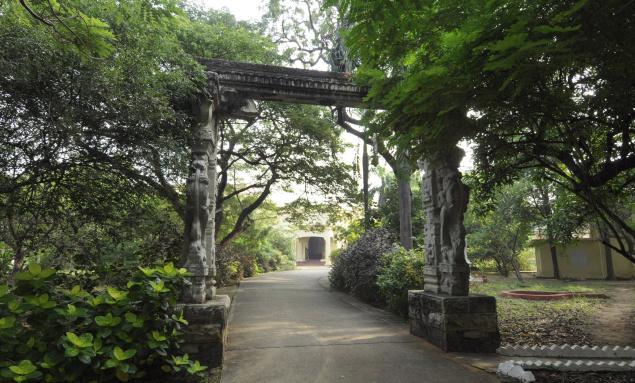Natural beauty of the kind found in Theosophical Society is fast vanishing. / Photo: N. Sridharan / The Hindu
To breathe the air of the Theosophical Society and smell the fragrances of its diverse vegetation while listening to a recent lecture at the Blavatsky bungalow inside its sprawling campus, just beyond the Adyar bridge, was to be overcome by a deep sense of loss of a past rich in simple beauty of a kind that rapid urbanisation has banished from our midst in the last couple of decades.
The quiet of the afternoon punctuated only by birdcalls and greenery all around us created an impression of a faraway place completely divorced from the cityscape we had left barely half a kilometre behind.
The bungalow is right next to the great banyan tree under which Rukmini Devi Arundale had her arangetram, back in December 1935.The last time I had spent any length of time inside the TS had been in 1986 when she passed away.
Her cottage inside the society was a perfect example of the simple beauty and grace social activist Aruna Roy spoke of during a recent talk at Kalakshetra recalling her own student days at the institution. The gleaming red floor, the Pattamadai mats and functional but elegant cane and wooden furniture were minimalist if anything; and the house was airy and sunlit.
There had been an endless stream of mourners coming in all morning to pay their last respects to Athai, as the great lady was known in dance circles. Men and women congregated quietly in small groups. Some of them chanted and sang softly, reverentially, spontaneously.
The human drama is never complete on such occasions without a touch of the comic, and relief was provided by a few self-proclaimed torchbearers of bharatanatyam. Each of them informed the print and TV journalists present that Athai had specifically but confidentially told her that she was the successor she expected to take her legacy forward.
The funeral procession to the cremation ground adjoining Kalakshetra in Thiruvanmiyur was again a picture of dignified, graceful solemnity, marked by a silence seldom seen in our part of the world.
As we came out of Blavatsky Bungalow—where young J Krishnamurti and his brother Nitya probably had their first glimpses into the world of theosophy, still unaware that their lives would soon be turned upside down—I remembered the extraordinary people who once walked there.
I remembered the impact of the magnetic presence of Rukmini Devi as she sat next to her much-loved lieutenant Sankara Menon in the driver’s seat of her Fiat; I remembered lying sprawled on the lawns of nearby Vasanta Vihar and listening to the gentle but mesmeric tones of Krishnamurti; I remembered the many teachers, musicians and dancers who cycled everywhere in their dhotis and cotton saris; I remembered the countless hours I spent at the Adyar Library in the 1960s; I remembered Mary Lutyens’s description of Adyar in her biography of Krishnamurti as the most beautiful place in the world.
And I felt blessed that Adyar had once been part of my life.
source: http://www.TheHindu.com / Home> News> Cities> Chennai / by V. Ramnarayan / November 18th, 2012
